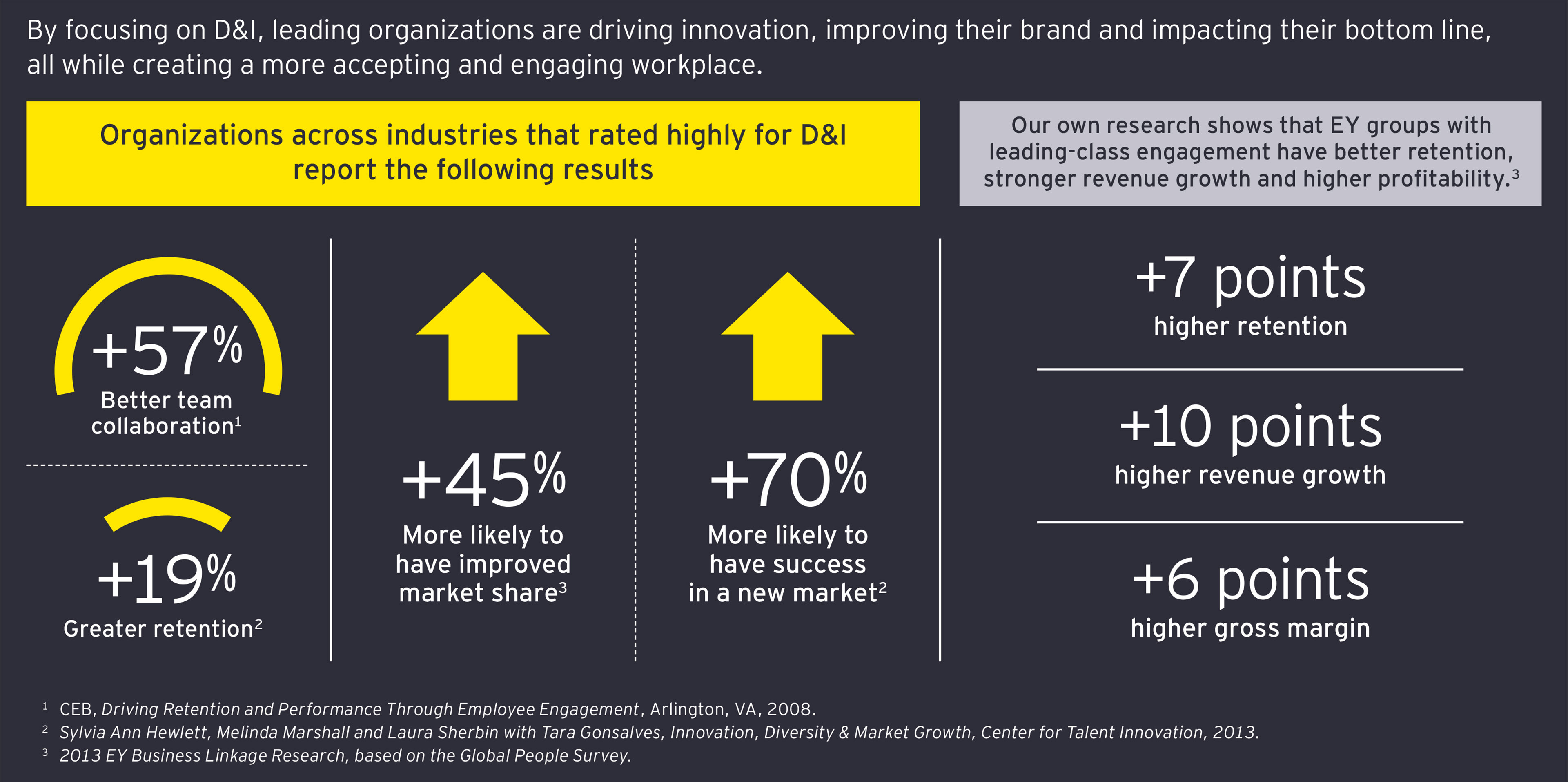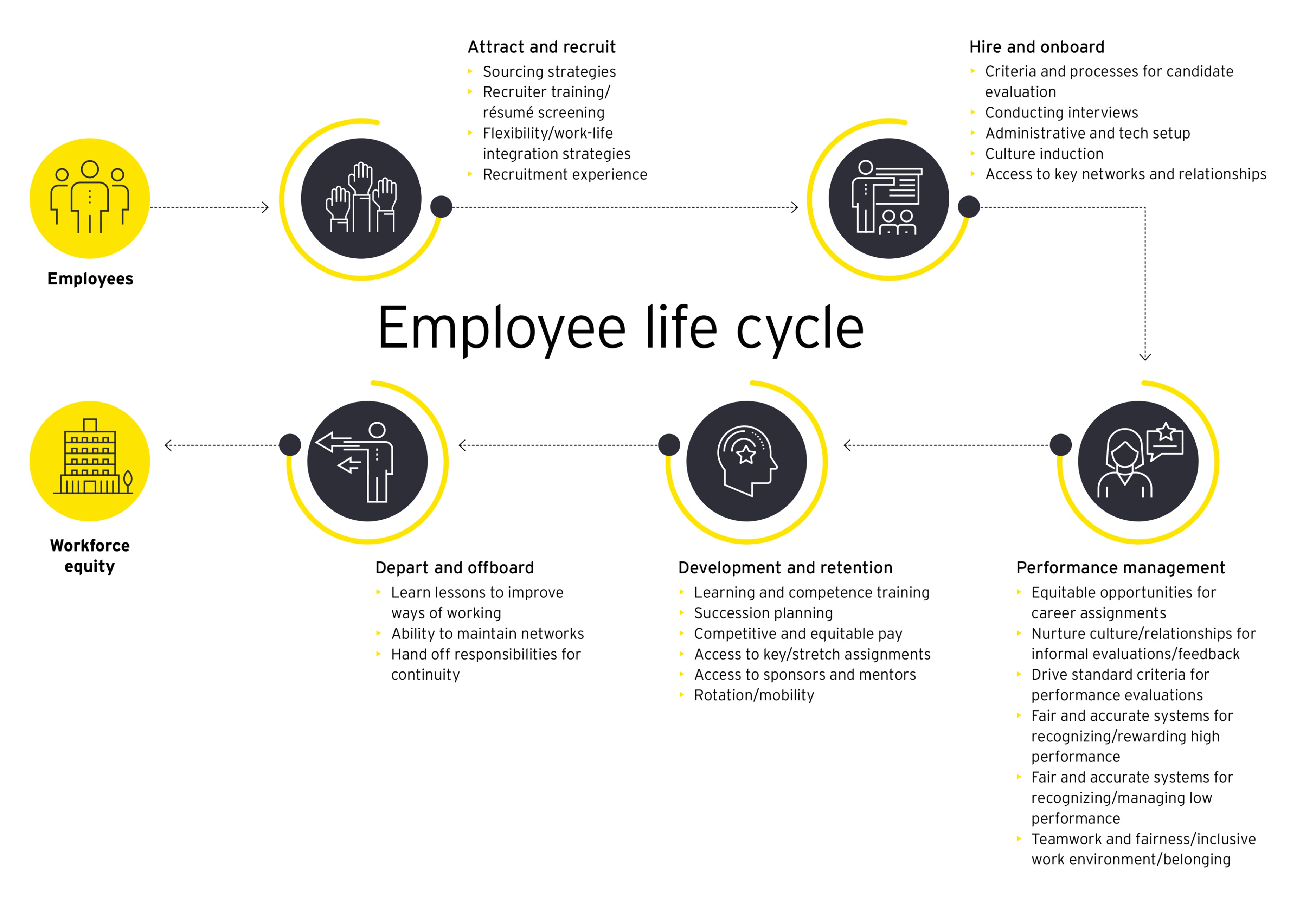In the midst of the most significant social justice movements in decades, society is issuing new imperatives for permanent shifts that deliver equity to racial minorities and other diverse groups.
To support board leadership on RDEI, we offer perspectives on the connection between diversity, corporate performance and value; we suggest specific steps boards can take to lead on RDEI; and we offer a framework for designing and implementing enterprise-wide diversity to address business and social demands and drive long-term corporate value.
Chapter 1
Diversity is critical to corporate performance and value
Human capital is an increasing area of focus as the workforce rapidly transforms.
Investors, regulators and other market participants identify human capital — a company’s people, talent pool or workforce — as a significant corporate asset and key driver of long-term value. This is increasingly an area of focus as the workforce rapidly transforms and digitization and automation change how business gets done. New demands for virtual work, broadening preferences for contingent and contract work, and five generations moving through the workforce are also having an impact.
For years, investors have called on boards to more rigorously oversee the management and value of their companies’ workforce and understand how it aligns with the company’s strategy and long-term-value proposition. There is extensive evidence showing that companies with diverse talent and leadership have a strong competitive advantage and that diversity is a key enabler of innovation, growth and profitability, driving performance and value across a wide range of indicators.

Studies also show that companies in the bottom quartile for both gender and ethnic/cultural diversity are significantly less likely to achieve above-average profitability.¹
Similarly, research shows that diversity on boards improves board effectiveness and corporate performance, including reduced financial risk, lower stock price volatility, more consistent investment in research and development and higher return on investment capital.²
Chapter 2
Board leadership in meeting stakeholder demands and driving RDEI
RDEI has re-emerged as a key priority to drive business sustainability, performance and value.
Companies and their shareholders are shifting away from shareholder capitalism toward stakeholder capitalism. Stakeholder capitalism is now a mainstream governance concept: the concept being that companies are better able to deliver long-term value to shareholders/investors when they understand and address the needs of all stakeholders, including their customers, employees and the communities where they operate.
Current events are accelerating this shift. On this point, Skadden, Arps, Slate, Meagher & Flom recently wrote that “the COVID-19 pandemic and the increased attention to systemic racism following the killing of George Floyd add new and increasing complexity for boards of directors as they consider stakeholder interests in the context of navigating their businesses through economic head winds.” ³
Many companies are committing anew to advance racial equity and justice and drive further and faster RDEI progress.
As business environments change globally, with society, consumers and investors simultaneously demanding that companies achieve RDEI to maintain their social capital, or “license to operate,” boards and management are acknowledging the re-emergence of RDEI as a key priority to drive business sustainability, performance and value. In recent months, a multitude of companies, especially those with prominent brands or community impact, are committing anew to advance racial equity and justice and drive further and faster RDEI progress. Many of these companies are looking at diversifying not only their workforce but also the people with whom they do business, from legal advisors to suppliers.
Even before this year’s social justice movements, equity and inclusion for diverse groups was often cited as a core corporate value and goal. In examining new commitments to achieve corporate RDEI, some companies are learning that conventional practices may not be fully effective. They need to be more strategic and holistic in their approaches. They also need to consider how their board, management, and workforce profiles look to investors, consumers and other stakeholders. Diversity in boardrooms and across the workforce remains elusive: as reported by Pamela Newkirk, “despite decades of handwringing, costly initiatives, and uncomfortable conversations, organizations have, apart from a few exceptions, fallen far short of their [diversity] goals.” ⁴
Boards can better influence and lead their companies in strategically and systemically addressing the societal and performance drivers for RDEI within their own ranks, throughout the workforce and among their business partners.
Steps to take now include:
- Assess how the board and the company’s performance, social capital and long-term value are affected by their diversity profiles
- Engage with management and key stakeholders — especially current and prospective investors, customers and workforce — to define and determine how RDEI can benefit the company
- Achieve diversity on the board to enhance effectiveness and leadership and demonstrate the appropriate tone at the top
- Direct the CEO to form a permanent cross-functional management team to:
- Develop an enterprise-wide framework to implement an effective RDEI strategy that aligns to the company’s strategy, culture and long-term-value proposition
- Formulate company-specific RDEI objectives, goals and metrics to measure performance and alignment to corporate strategy, culture and performance
- Develop an RDEI scorecard to report to the board and investors on the company’s RDEI strategy and progress and their impacts on corporate performance, social capital and value
- Measure management’s performance on executing the company’s RDEI strategy within its ranks and in its areas of responsibility
- Consider how the company, its leadership and client-facing teams present to stakeholders, and regularly confirm that the company’s value statements match its actions and operations
- Improve oversight of strategy, culture, performance and long-term value by adding RDEI as a standing board agenda item to be discussed with those topics
Chapter 3
A strategic RDEI framework to support long-term value
Boards can drive corporate long-term value by supporting management in enabling enterprise-wide RDEI.
Because RDEI is proven to strengthen workforce performance, create competitive advantage and enhance corporate social capital, boards can drive corporate long-term value by supporting management in enabling enterprise-wide RDEI as a strategic imperative.
Strategic initiatives to systemically enable enterprise-wide RDEI in alignment with strategy and culture will allow companies to realize measurable improvements in day-to-day performance and long-term value. To illustrate that perspective, we suggest the following framework to support management design and board oversight of an RDEI strategy tailored to the company’s facts and circumstances and resulting in a dynamic and evolving diversity program continually aligned with corporate strategy, culture and long-term value.
Starting with an evaluation of the company’s long-term-value proposition and purpose, companies can embed RDEI as a “way of thinking” into strategy, culture and the company’s long-term-value drivers. Many leading companies, investors and governance professionals have identified four basic long-term drivers of corporate value: talent; innovation and consumer trends; social capital/ESG; and leadership and governance.⁵ Working back from the long-term-value perspective, companies can inventory their long-term-value drivers — including talent, consumer trends and other operational strategies — and embed RDEI initiatives across those drivers to address identified gaps in workforce and corporate performance.

This framework shows that there is no single recipe when it comes to diversity. Issues differ across companies and industries. Each company needs to design an RDEI strategy that meets its specific needs. Furthermore, because diversity is complex, companies with diverse talent pools need to identify and address the issues unique to enabling equity and inclusion for distinct groups.
Even after diversity strategies are effectively designed and launched, they can be systemically implemented, vigilantly monitored and periodically adjusted to address the evolving priorities of the company, its people and other key stakeholders.
Chapter 4
Bringing the framework to life
A clear vision is required for success.
Align strategy and culture to activate RDEI
The well-worn saying “culture eats strategy for breakfast” is repeated for a reason — strategy is accelerated when culture is aligned and impeded when it is not. There are, of course, programmatic solutions to RDEI, such as hiring initiatives or unconscious-bias training. We’ve learned over time they aren’t enough. Changing behaviors requires moving beyond programs to deliberately shifting everyday language, attitudes, behaviors and decisions – in other words – culture. Yet making these shifts is challenging: to succeed requires a clear vision and the consistent and persistent demonstration, communication, cultivation and reinforcement of the desired attitudes, behaviors and practices.
To illustrate this point, consider that:
- Culture includes both formal processes and informal, unwritten rules: Cultural change requires more than reconsidering official processes and procedures.
- Culture comprises both mindsets and behaviors: Changing culture is as much about changing what people think as it is about changing what they do.
- Culture is shared: Culture does not belong to just one group within the organization, such as leadership. Cultural change needs to involve everybody.
- Culture is self-reinforcing: Every time someone acts in a particular way, it sends out a visible and immediate signal to others in the organization.
Effecting cultural shifts to enable systemic change requires buy-in and participation from not only the board and executive management, but each individual at the company. All leaders throughout the company can be engaged and demonstrate the desired behaviors and communications to create a consistent and persistent tone. The board and especially the CEO are foundational in this effort.
To guide management in evolving the culture needed to activate RDEI, boards should take steps to identify specific beliefs, states and actions that may be hindering progress on RDEI and develop values-based “From-To” positions to guide the company from where it is to where it wants to be on specific attitudes and behaviors. Values have to be operationalized into behaviors and formed into attitudes, which are reinforced consistently to form habits leading to new ways of strategically working and collaborating.
Based on discussions with racially diverse board members and executives, including executives leading best-in-class RDEI programs, we have identified potential “From-To” perspective and behavioral shifts that can help inform the culture adjustments needed to enable RDEI as a strategic imperative that drives performance.

Develop human capital management strategies to enable RDEI
Building a truly diverse board and workforce can raise tactical human capital management challenges. Primary impediments are often cited as stemming from constraints in resources and the talent pipeline. Companies are learning that these constraints can be overcome when boards and management modernize their perspectives and practices in looking for talent, such as by implementing the Rooney Rule+ (requiring more than one diverse candidate for each open position on the board, in management and throughout the company) and sourcing talent from historically Black colleges and universities. They should also expand their processes, inquiry and outreach to include a broader and fresher range of candidates for hiring, promotion and high-visibility projects. Companies are also learning that achieving RDEI goals need not demand significant additional resources, but rather clearer leadership, better strategies and more effective resource allocation.
To attract, retain and engage the best talent, RDEI can be embedded in the company’s human capital management programs throughout all steps in the employee life cycle on an enterprise-wide basis. This starts with developing more effective sourcing strategies to realize diverse candidate pipelines for positions across the company — from entry level to leadership ranks.
As talent moves through the workforce, human capital management programs can enable equitable opportunity, learning, advancement, compensation and reward for all diverse talent. The life cycle should provide, early on, a tangible sense a sense of belonging — as discussed below — for all the company’s people to fully realize their potential and value.

Driving enterprise-wide RDEI requires board leadership and a collaborative effort among C-suite executives and other leaders throughout the management hierarchy. This is because RDEI is directly relevant not only to strategy, talent, culture and performance but also to risk management, legal and compliance, marketing and investor relations. The CEO should lead a cross-functional team that is responsible for executing RDEI strategies across all areas.
Boards should proactively ask the CEO and other management how they connect, realize synergies and avoid inconsistent messages on RDEI, culture and strategy and achieve identified objectives. Boards should seek regular reporting on how the company’s cross-functional RDEI activities are impacting corporate performance in specific operational areas and on employee engagement and performance.
RDEI should also be embedded in risk management and corporate compliance. Company codes of business conduct and ethics and all related policies and procedures need to fully align with the company’s strategy, culture and RDEI goals and initiatives. Boards should regularly monitor the effectiveness of the company’s code and related policies and procedures related to diversity and inclusion, anti-discrimination and anti-harassment. Management needs to clearly communicate, vigilantly monitor and enforce these policies and procedures — celebrating people who do the right thing and holding them accountable when they don’t.
In view of the connection between RDEI and performance, boards should consider whether CEO and executive management incentive compensation should be based in part on achievement on RDEI as measured by metrics formulated to track RDEI progress against goals and to link RDEI to long-term value.
Evolve RDEI to “belonging” to realize long-term value
Barriers to diverse groups can be both actual, in the form of systems and processes that exclude or limit diverse groups, and perceived, as in environments where diverse groups can be and are present but experience feelings of exclusion, bias, discomfort and prejudice. Both actual and perceived barriers are real impediments to the progress of diverse groups and society generally. Yet all people — even board directors and corporate executives — might understand the feeling of being an “outsider” — someone who does not fully belong, whose voice is unheard, who suppresses their true identity and creates one that conforms to applicable norms.
As society and workplaces become more diverse, the company’s culture, leaders and people should continuously collaborate to cultivate a strong sense of belonging to engage and empower everyone to enable high performance and trust. People at high-trust companies report significantly more energy and engagement and significantly less stress and burnout, resulting in significantly higher productivity.
As they examine and oversee RDEI, boards must consider the concepts of belonging and trust, their logical benefits and connections to corporate performance and value, and how they can work with management to cultivate a corporate culture that gives rise not just to RDEI but also to a strong sense of belonging for all the company’s talent. Indeed, where belonging is not a product of corporate culture and diversity initiatives, more work is needed.
By evolving RDEI to belonging, companies can deliver equitable opportunity, sustainability and prosperity for people, businesses and society in ways that more fully meet the business and social imperatives flowing from current events and global business trends. In doing so, they enhance their own sustainability and long-term value.
Questions for the board to consider
- How should the board and management define and determine how RDEI can benefit the company?
- Is the CEO appropriately motivated and determined to make a difference on the issue of racial diversity, equity and inclusion and to set with the board the right tone from the top?
- What evidence should the board expect for the company moving beyond RDEI values to resourcing and operationalizing inclusive behaviors?
- What information and data are needed to understand how the company’s performance and value can be enhanced through improved diversity?
- How effective is board reporting and other data in communicating the current and desired state of racial diversity, equity and inclusion at all levels of the organization?
- Does the board understand the information and data reflecting racial diversity, equity and inclusion in relation to hiring, retention, pay levels, promotions and all milestones throughout an employee’s journey in the organization?
- Does the CHRO have the appropriate resources and support of the C-suite to collaboratively design and implement an enterprise-wide RDEI strategy?
- How is the board ensuring that activity related to RDEI is not limited to policies and statements but is rigorously monitored and periodically adjusted to achieve desired outcomes?
- Does the board’s composition and director nomination processes reflect the company’s commitments to RDEI?
Summary
We offer perspectives on the connection between diversity, corporate performance and value; highlight potential perspective and behavioral shifts for boards to consider; and provide a framework to enable enterprise-wide RDEI.

